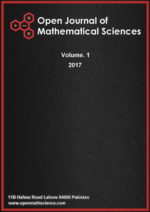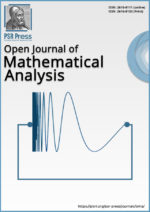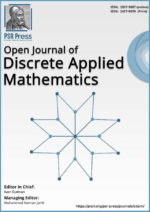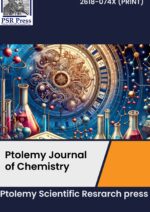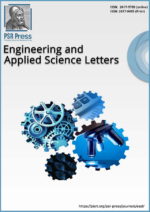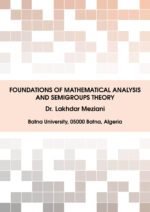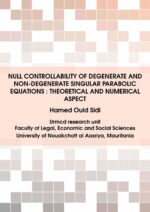Ptolemy Scientific Research Press (PSR Press)is a highly regarded publisher of scientific literature dedicated to bringing the latest research and findings to a broader audience. With a focus on cutting-edge research and technology, Ptolemy Scientific Research Press offers a range of publications catering to professionals, researchers, and student’s needs. Whether looking for information on the latest breakthroughs in physics, biology, engineering, or computer science, you can trust Ptolemy Scientific Research Press to deliver insightful, accurate, and engaging content. With its commitment to quality, accessibility, and innovation, Ptolemy Scientific Research Press is an essential resource for anyone interested in science and technology.

Latest Published Articles
OMS-Vol. 2 (2018), Issue 1, pp. 287–300 Open Access Full-Text PDF
Rahmatullah Ibrahim Nuruddeen, Bashir Danladi Garba
Abstract:In the present article, a time fractional diffusion problem is formulated with special boundary conditions, specifically the nonlocal boundary conditions. This new problem is then solved by utilizing the Laplace transform method coupled to the well-known Adomian decomposition method after employing the modified version of Beilin’s lemma featuring fractional derivative in time. The Caputo fractional derivative is used. Some test problems are included.
Analytic Functions of Complex Order Defined by New Differential Operator
OMS-Vol. 2 (2018), Issue 1, pp. 266–286 Open Access Full-Text PDF
Abdussalam Eghbiq, Maslina Darus
Abstract:In this paper, we introduce and study the classes \(S_{n,\mu}(\gamma,\alpha,\beta,\) \(\lambda,\nu,\varrho,\mho)\) and \(R_{n,\mu}(\gamma,\alpha,\beta,\lambda,\nu,\varrho,\mho)\) of functions \(f\in A(n)\) with \((\mu)z(D^{\mho+2}_{\lambda,\nu,\varrho}(\alpha,\omega)f(z))^{‘} \) \(+(1-\mu)z(D^{\mho+1}_{\lambda,\nu,\varrho}(\alpha,\omega)f(z))^{‘}\neq0\), where \(\nu>0,\varrho,\omega,\lambda,\alpha,\mu \geq0, \mho\in N_{0}, z\in U\) and \(D^{\mho}_{\lambda,\nu,\varrho}(\alpha,\omega)f(z):A(n)\longrightarrow A(n),\) is the linear differential operator, newly defined as
\( D^{\mho}_{\lambda,\nu,\varrho}(\alpha,\omega)f(z)=z-\sum_{k=n}^{\infty}\left( \dfrac{\nu+k(\varrho+\lambda)\omega^{\alpha}}{\nu} \right)^{\mho} a_{k+1}z^{k+1}. \)
Several properties such as coefficient estimates, growth and distortion theorems, extreme points, integral means inequalities and inclusion relation for the functions included in the classes \(S_{n,\mu} (\gamma,\alpha,\beta,\lambda,\nu,\varrho,\mho,\omega)\) and \(R_{n,\mu}(\gamma,\alpha,\beta,\lambda,\nu,\varrho,\mho,\omega)\) are given.
\( D^{\mho}_{\lambda,\nu,\varrho}(\alpha,\omega)f(z)=z-\sum_{k=n}^{\infty}\left( \dfrac{\nu+k(\varrho+\lambda)\omega^{\alpha}}{\nu} \right)^{\mho} a_{k+1}z^{k+1}. \)
Several properties such as coefficient estimates, growth and distortion theorems, extreme points, integral means inequalities and inclusion relation for the functions included in the classes \(S_{n,\mu} (\gamma,\alpha,\beta,\lambda,\nu,\varrho,\mho,\omega)\) and \(R_{n,\mu}(\gamma,\alpha,\beta,\lambda,\nu,\varrho,\mho,\omega)\) are given.
Simultaneous Determination of Fexofenadine HCl and Pseudoephedrine HCl in Combined Pharmaceutical Dosage Form
OJC-Vol. 1 (2018), Issue 1, pp. 01–11 | Open Access Full-Text PDF
Sajid Mahmood, Muhammad Arshad, Zaheer Ahmed
Abstract:The objective of the present work was to develop and validate of an analytical method for the quantitative determination of Fexo. HCL and Pseudo. HCL in a combine tablet dosage form by \(UV-V\) is spectrophotometry and TLC. The main problem was to separate the two active ingredient from a single bilayered tablet because both the A.P.I’s were soluble in the same solvents. As media selection, distilled water and ethanol \((1:1)\) were used for Pseudo. HCl and methanol for Fexo. HCl, in which both the drugs were soluble and stable for a sufficient time. Both drugs were measured at \(220\)nm and \(247\)nm, where they showed maximum absorbance. Beer Lambert’s law was obeyed at concentration range \(4-14\) ppm and \(5-30\) ppm for Fexo. HCL and Pseudo HCL respectively. Fexo. HCl \((Y=0.0643x+0.9370)\) was measured with correlation coefficient \(r =0.9574\) and Pseudo. HCl \((Y=0.0843x+0.0219)\) with correlation coefficient \(r =0.9992\). The results of analysis have been validated statistically and recovery studies were carried out as \(99.29\%\pm 0.943\) and \(99.29\%\pm 0.941\) which were close to the assay value \(100.1\% \& 100.6 \%\). Precision of the method was measured which showed results for SD \((99.57 \% \;\;\& \;\;99. 51% )\) and \(\%\) RSD \((99.53 \%\;\; \&\;\; 99.54)\). The proposed method may be suitably applied for the analysis of Fexo. HCL and Pseudo.HCL in tablet pharmaceutical formulation for routine analysis.
Degree Subtraction Adjacency Eigenvalues and Energy of Graphs Obtained From Regular Graphs
ODAM-Vol. 1 (2018), Issue 1, pp. 08–15 | Open Access Full-Text PDF
Harishchandra S. Ramane, Hemaraddi N. Maraddi
Abstract:Let \(V(G) = \{v_1, v_2, \ldots, v_n\}\) be the vertex set of \(G\) and let \(d_{G}(v_i)\) be the degree of a vertex \(v_i\) in \(G\). The degree subtraction adjacency matrix of \(G\) is a square matrix \(DSA(G)=[d_{ij}]\), in which \(d_{ij}=d_{G}(v_i)-d_{G}(v_j)\), if \(v_i\) is adjacent to \(v_j\) and \(d_{ij}=0\), otherwise. In this paper we express the eigenvalues of the degree subtraction adjacency matrix of subdivision graph, semitotal point graph, semitotal line graph and total graph of a regular graph in terms of the adjacency eigenvalues of \(G\). Further we obtain the degree subtraction adjacency energy of these graphs.
Some Numerical Invariants Associated with V-phenylenic Nanotube and Nanotori
EASL-Vol. 1 (2018), Issue 1, pp. 01–09 | Open Access Full-Text PDF
Rachanna Kanabur, Sunilkumar Hosamani
Abstract:A carbon nanotube (CNT) is a miniature cylindrical carbon structure that has hexagonal graphite molecules attached at the edges. In this paper, we compute the numerical invariant (Topological indices) of linear [n]-phenylenic, lattice of \(C_{4}C_{6}C_{8}[m, n]\), \(TUC_{4}C_{6}C_{8}[m, n]\) nanotube, \(C_{4}C_{6}C_{8}[m, n]\) nanotori.
Effect of Magnetic Field on Double Convection Flow of Viscous Fluid over a Moving Vertical Plate with Constant Temperature and General Concentration by using New Trend of Fractional Derivative
OMS-Vol. 2 (2018), Issue 1, pp. 253–265 Open Access Full-Text PDF
Nehad Ali Shah, Ahmad Hajizadeh, Muhammad Zeb, Sohail Ahmad, Yasir Mahsud, Isaac Lare Animasaun
Abstract:This article presents, effects of fractional order derivative and magnetic field on double convection flow of viscous fluid over a moving vertical plate with constant temperature and general concentration. The model is fractionalized by using Caputo-Fabrizio derivative operator. Closed form solutions of the fluid velocity, concentration and temperature are obtained by means of the Laplace transform. Numerical computations and graphical illustrations are used in order to study the effects of the Caputo-Fabrizio time-fractional parameter , magnetic parameter , Prandtl and Grashof numbers on velocity field.

